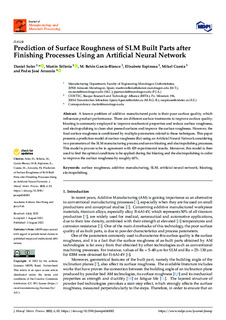| dc.rights.license | Attribution 4.0 International | * |
| dc.contributor.author | Soler Mallol, Daniel | |
| dc.contributor.author | Telleria, Martin | |
| dc.contributor.author | CUESTA ZABALAJAUREGUI, MIKEL | |
| dc.contributor.author | ARRAZOLA, PEDRO JOSE | |
| dc.contributor.other | García-Blanco, M. Belén | |
| dc.contributor.other | Espinosa, Elixabete | |
| dc.date.accessioned | 2022-10-04T11:59:56Z | |
| dc.date.available | 2022-10-04T11:59:56Z | |
| dc.date.issued | 2022 | |
| dc.identifier.issn | 2504-4494 | en |
| dc.identifier.other | https://katalogoa.mondragon.edu/janium-bin/janium_login_opac.pl?find&ficha_no=168250 | en |
| dc.identifier.uri | https://hdl.handle.net/20.500.11984/5714 | |
| dc.description.abstract | A known problem of additive manufactured parts is their poor surface quality, which influences product performance. There are different surface treatments to improve surface quality: blasting is commonly employed to improve mechanical properties and reduce surface roughness, and electropolishing to clean shot peened surfaces and improve the surface roughness. However, the final surface roughness is conditioned by multiple parameters related to these techniques. This paper presents a prediction model of surface roughness (Ra) using an Artificial Neural Network considering two parameters of the SLM manufacturing process and seven blasting and electropolishing processes. This model is proven to be in agreement with 429 experimental results. Moreover, this model is then used to find the optimal conditions to be applied during the blasting and the electropolishing in order to improve the surface roughness by roughly 60%. | en |
| dc.description.sponsorship | Gobierno de España | es |
| dc.description.sponsorship | Gobierno Vasco | es |
| dc.language.iso | eng | en |
| dc.publisher | MDPI | en |
| dc.rights | © 2022 by the authors. Licensee MDPI | en |
| dc.rights.uri | http://creativecommons.org/licenses/by/4.0/ | * |
| dc.subject | surface roughness | en |
| dc.subject | additive manufacturing | en |
| dc.subject | SLM | en |
| dc.subject | Artificial Neural Networks | en |
| dc.subject | blasting | en |
| dc.subject | electropolishing | en |
| dc.title | Prediction of Surface Roughness of SLM Built Parts after Finishing Processes Using an Artificial Neural Network | en |
| dcterms.accessRights | http://purl.org/coar/access_right/c_abf2 | en |
| dcterms.source | Journal of Manufacturing and Materials Processing | en |
| local.contributor.group | Mecanizado de alto rendimiento | es |
| local.description.peerreviewed | true | en |
| local.identifier.doi | https://doi.org/10.3390/jmmp6040082 | en |
| local.relation.projectID | info:eu-repo/grantAgreement/GE/Ayudas Cervera para Centros Tecnológicos CDTI 2019/CER-20191003/ES/Red de Excelencia en Tecnologías de funcionalización Superficial para Aplicaciones en Sectores de Alto Impacto Económico y Social/SURF-ERA | en |
| local.relation.projectID | info:eu-repo/grantAgreement/GV/Elkartek 2019/KK-2019-00077/CAPV/Superficies multifuncionales en la frontera del conocimiento/FRONTIERS V | en |
| local.rights.publicationfee | APC | en |
| local.rights.publicationfeeamount | 0 EUR | en |
| local.contributor.otherinstitution | https://ror.org/03vgz7r63 | es |
| local.source.details | Vol. 6. N. 4. Artículo 82. August, 2022 | en |
| oaire.format.mimetype | application/pdf | |
| oaire.file | $DSPACE\assetstore | |
| oaire.resourceType | http://purl.org/coar/resource_type/c_6501 | en |
| oaire.version | http://purl.org/coar/version/c_970fb48d4fbd8a85 | en |








